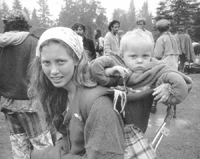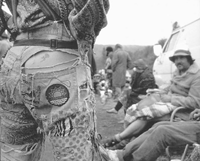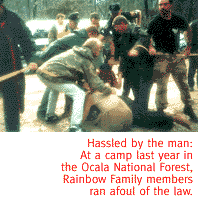
Federal And State Officials Gear Up For A 20,000-Member Gathering Of The Rainbow Family.
By Dave Irwin
THE FREAK FLAG will be flying high--very high--over Arizona
this summer.
In a few weeks, the Rainbow Family of Living Light will designate
a site in one of Arizona's six national forests for its annual
Gathering, to be celebrated June 28 through July 10. That no one
knows exactly where, is of considerable concern to authorities,
since the event will draw an estimated 20,000 people, many of
the so-called "hippie" persuasion.
 Gov. Jane Dee Hull's office hosted a meeting on May 15 to begin
coordinating between federal, state and local authorities. Although
the Governor's Office declined to list who attended or specifics
of the discussion, citing law-enforcement concerns, the guests
included the U.S. Attorney's Office, the Arizona Attorney General's
Office, the U.S. Forest Service, U.S. Sen. Jon Kyl's office, the
state Division of Emergency Management and local law-enforcement
representatives.
Gov. Jane Dee Hull's office hosted a meeting on May 15 to begin
coordinating between federal, state and local authorities. Although
the Governor's Office declined to list who attended or specifics
of the discussion, citing law-enforcement concerns, the guests
included the U.S. Attorney's Office, the Arizona Attorney General's
Office, the U.S. Forest Service, U.S. Sen. Jon Kyl's office, the
state Division of Emergency Management and local law-enforcement
representatives.
"What I can tell you is the Governor's Office is aware that
these folks are looking at coming here," said Francine Noyes,
Hull's spokeswoman. "We're trying to monitor the situation,
but beyond that now, there isn't much we can do yet. We have a
number of concerns about sanitation, law enforcement, health and
safety..."
Rainbow Gatherings have been held in national forests every summer
since 1972. The Rainbow Family of Living Light describes itself
as the "largest non-organization of non-members in the world."
More mindset than organization, it has no set structure, no mission
statement and no hierarchical leadership.
"No one speaks for the Rainbow," the unofficial website
admonishes. Only half joking, they say membership is open to "anyone
with a belly button."
In addition to the annual national Gathering, there are a number
of regional gatherings, as well as numerous local pot lucks and
drum circles. The national Gathering was held in Arizona once
before, in 1979 on the Apache Sitgreaves National Forest.
 For a month now, Rainbow Family scouts have been "on the
ground," looking over topo maps, driving back roads, searching
for a site that will meet the requirements of available water,
adequate parking and attractive camping for 20,000 squatters.
Leading contenders appear to be Coconino and Apache Sitgreaves
National Forests. The scouts will make a proposal at the Arizona
Spring Council, to be held this Saturday and Sunday somewhere
in the national forest, after which, the Council may choose a
site. Or not. This is the Rainbow Family after all and no one
is really in charge. Decisions, if and when they are reached,
are by consensus.
For a month now, Rainbow Family scouts have been "on the
ground," looking over topo maps, driving back roads, searching
for a site that will meet the requirements of available water,
adequate parking and attractive camping for 20,000 squatters.
Leading contenders appear to be Coconino and Apache Sitgreaves
National Forests. The scouts will make a proposal at the Arizona
Spring Council, to be held this Saturday and Sunday somewhere
in the national forest, after which, the Council may choose a
site. Or not. This is the Rainbow Family after all and no one
is really in charge. Decisions, if and when they are reached,
are by consensus.
Garrick Beck is a long-standing member of the Rainbow Family.
He's missed only two national Gatherings. He has deep counterculture
roots as the son of Julian and Judith Beck, founders of the Living
Theatre, a famous and controversial '60s guerrilla theatre troupe.
Having been there from the beginning, he traces the Rainbow Family's
lineage from influences of civil-rights marches, the then-new
ecology movement, a variety of spiritual movements, hippies and
Happenings, rock concerts and the melding of antiwar protesters
and Vietnam veterans.
"The Gatherings grew out of a need from the cultural changes
in the '60s to create an event that was very inclusive,"
Beck recalls. "The coming together of returning Vietnam veterans
and peace movement activists gave the early gatherings a lot of
their strength.
"Most organizations have a hierarchy of people in charge
of different things in a pyramid-shaped form. We're organized
much more like a living cell. The key is communication between
the parts and each part doing its job well," Beck adds. "More
than anything else the Gatherings teach people to live in harmony
with the earth, not as a vague ideal, but as a practical activity.
The No. 1 thing people should expect is to find a large, very
open-hearted community in the woods."
GATHERINGS ARE MADE up of 60 to 200 "neighborhoods,"
including kitchens, outdoor latrines, water supplies and camping
areas. A meadow serves as the primary gathering place, although
activities are dispersed throughout the site. An information booth
handles questions, messages and scheduling. Food preparation is
monitored, as is water quality.
Medical facilities are staffed with volunteer doctors and nurses.
The emphasis is on creating a temporary community where individuals
act responsibly, volunteering for chores such as cooking, cleaning
up, parking cars, moving materials or whatever is needed.
"One of the things about the Gatherings is that services
are provided so efficiently for such a remote area," Beck
notes. "It takes a lot of plain old-fashioned cooperation."
Over the two weeks, hundreds of events and activities are available,
from nature hikes to workshops on dozens of topics to impromptu
parades to musical entertainment, including the ubiquitous drum
circles.
Councils, made up of whoever's in attendance, make operational
decisions, such as food distribution or solid-waste management
(a considerable concern for a city of 20,000 with no sewer system).
Other councils hold discussions on topics such as spirituality,
social issues or the environment.
For children, there are clowns and mimes, supervised play areas,
art activities, exercise and storytelling.
 The Gathering peaks on July 4, when participants form a giant
circle at noon to chant "om" and pray for world peace.
The Gathering peaks on July 4, when participants form a giant
circle at noon to chant "om" and pray for world peace.
As part of the utopian nature of the Gathering, drug use is openly
tolerated and clothing is optional.
People planning to attend should arrive prepared with comfortable,
waterproof camping gear, a bowl, cup and utensils. Information
on the location will be posted as soon as it's available on the
unofficial website, www.welcomehome.org/ rainbow.html, and at
the newsgroup, alt.gathering.rainbow. It will also be a major
buzz on the street, so check with your local crustypunk.
THERE ARE TENS of thousands of people who have come to
the Gatherings and discovered that community isn't something that's
brought to you by the corporations and the police, fire and garbage
departments. It's brought to you by the people who live in your
community, who are your neighbors working together," Beck
says.
Aron "Pieman" Kay, a self-proclaimed hippie who has
become somewhat infamous by zapping famous people in the kisser
with pies just for the zen of it, has been attending Gatherings
since the '80s. He also attended Love-Ins and was at the Rolling
Stones disaster at Altamont in 1969.
The son of Holocaust survivors, he held his 12-year-old daughter's
Bat Mitzvah at a Gathering.
"It's not a '60s party," Kay says. "It's not sex,
drugs and rock and roll. We just want to communicate with our
mother, Mother Earth. We just want to heal the earth and heal
the children."
At the end of the Gathering, a team stays behind to return the
site to its natural condition. They see to it, according to Beck,
that "not only the fire ring of stones is dismantled, but
that the ashes are composted, all the holes are filled in, every
piece of string tied to a tree is removed. The areas that were
compacted by people's feet are aerated with hand tools so that
the roots can grow again. The forest floor material is scattered
in a random, natural fashion, so there aren't any clearings left
behind. All the trails disappear."
ROSE DAVIS HAS been to four gatherings so far.
However, the former Flagstaff resident works on the other side
of the fence. She's the information officer for the Forest Service's
National Incident Management Team, which is assigned to provide
year-to-year management of the Gatherings for the Forest Service.
 "So far, the sites have all healed nicely," Davis concedes.
"The fact that they have to heal and that there are rehabilitation
efforts involved is something we have to look at. Digging slit
latrines in the national forest is something that we're not pleased
about. But they do work with the district. After about a year
or so when the land heals, it's turned out real well."
"So far, the sites have all healed nicely," Davis concedes.
"The fact that they have to heal and that there are rehabilitation
efforts involved is something we have to look at. Digging slit
latrines in the national forest is something that we're not pleased
about. But they do work with the district. After about a year
or so when the land heals, it's turned out real well."
From the Forest Service side, she cites problems in terms of
illegal drugs, public nudity, runaways and traffic control.
"A lot of the potential conflict can arise from culture
shock for the local community," Davis explains. "Once
they announce the Gathering site, there is an element of folks
that come in because it's a safe place to hide and there's the
possibility of a free meal. These can include runaways, homeless
people, individuals running from the law. Unfortunately, that
element tends to hit town first. Then that community sees problems
like dumpster diving, shoplifting, public urination."
Coconino County Sheriff Joe Richards notes that, "Over the
past six to eight weeks, our department has seen about 200 Rainbow
types in and around the area."
A Forest Service source also noted that approximately 20-30 small
Rainbow camps have sprung up in the woods around Flagstaff, waiting
for word on where to go.
Beck says, "There are people at the Forest Service who believe
the Rainbow Gatherings are just a plain, old criminal act and
we should be rounded up and arrested for our beliefs. Other people
in the Forest Service believe the Gatherings educate more young
people to the value of the heritage of the national forest than
any other single activity."
The annual yin/yang between the Rainbows and the Forest Service
will continue this year, with the Forest Service enforcing regulations
requiring a use permit for any gathering of more than 75 people
in the national forest. The Rainbows steadfastly refuse to obtain
the required permits, citing the Gatherings as a constitutional
right to assemble peaceably on public lands.
"We will require a permit as soon as the number of people
at the site exceeds 75," Davis asserts. "We hope it's
not confrontational, but we're trying to enforce the federal regulations
as we're required by law."
Law enforcement has generally stayed outside of the Gatherings.
"Where they can, they enforce everything that they have responsibility
for, but officer safety is very important and they are well outnumbered,"
Davis notes.
There's a question whether officials will use a policy of interdiction
around the Gathering, setting up checkpoints and strictly enforcing
traffic laws. Attendees consider such interdiction harassment.
 "We're more concerned about major felonies," Sheriff
Richards says. "Child abuse, assault, theft."
"We're more concerned about major felonies," Sheriff
Richards says. "Child abuse, assault, theft."
"There is an understanding," Beck says, "that
there is no buying or selling at the Gatherings of anything, food,
parking spaces, anything. So it's not a good place for anyone
to come looking to buy or sell drugs. When you consider how little
drug-related violence there's been in more than 25 years of Gatherings
and then how much drug-related violence there is in modern America,
then maybe we're on to something."
IN ANY CASE, for more than 25 years, the Rainbow Gatherings
have represented the largest single recreational use of the national
forests, a fact that the Forest Service is reluctant to accept
officially.
"There are instances when we've had really beautiful, golden
cooperative relations with the Forest Service," Beck notes,
"and there have been instances where we've had a really knucklehead
group of Forest Service officials who've not been willing to give
us the time of day."
So it comes down to your view. For the Rainbow Family, the Gathering
is an utopian Club Med, a temporary autonomous zone where there
are no leaders, only focalizers to lead discussions, and where
order is kept by shanti sena, a community-based combination of
intervention counselors, peacekeepers and communicators. It's
a hippie Tomorrowland where marijuana is "green energy"
and the Magic Hat garners donations of more money than expected.
To government officials, it's a gathering of marginal lifestyles
where illegal activities are rampant and hygiene is iffy.
"It's definitely a study in sociology, I'll give you that,"
Davis says with a laugh. "It basically becomes a small city
on the national forest. It pops up quickly and it's pretty amazing."

|





